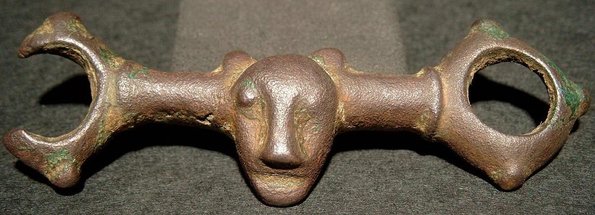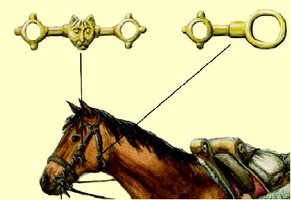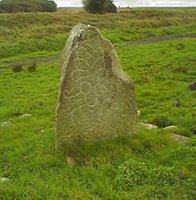The horse harness strap joiner - the face in the crowd
Back to another intruiging part of the Viking Age horse equestrian equipment: the horse harness strap joiner.
I will use 'horse harness strap joiner' as there appears to be a tree of terms to describe these kind of artefact, as : horse harness strap distributor, horse harness strap fitting, horse bridle fitting, horse harness strap junction, horse harness checck piece and even horse harness mount..
These horse harness strap joiners are an 11th century feature within England, and can be addressed 'Viking-Age' although they diverse stylistically between 'Anglo-Saxon' or 'Anglo-Scandinavian'. A thorough reference to these specific type of equestrian equipment seems to be lacking to me. A book like 'The medieval horse and its equipment' - Medieval finds from excavations in London c. 1150 - c. 1450 AD by John Clark regrettably isn't addressing these.
The Late Saxon Stirrup-strap Mounts: A Classification and Catalogue by David Williams is adressing stirrup mounts and terminals but no other parts of equestrian equipment.
Nevertheless ! If someone can give a better reference to these horse harness strap joiners, let me know ! Back to the subject..
The horse harness strap joiner was part of the bridle of the horse, and like stirrup mounts and terminals and horse harness pendants were executed in a very adorned style..
The horse harness strap joiner on top is of Anglo-Saxon type. It is a cheeck piece with face decoration. These 'faces' are executed in very diverse form, as is the main purpose of this article, as you are going to see.
Beneath, an image of the place on the horse harness where the horse harness strap joiner was placed.
The horse harness strap joiner slide show beneath shows a true Anglo-Scandinavian type. The 'mask' face is recalling images on stones from Denmark as the Sjellebro stone and the Aarhus mask stone, although in a very deformed way.. I have never seen this specific type of horse harness strap joiner before and it would have a very special meaning regrettably only known by the smith and its owner..
On the slide show beneath another form of a face horse harness strap joiner of Anglo-Saxon type. Although 'Anglo-Saxon' these type could also have been used by 'Anglo-Scandinavians' or true vikings. The image on this horse harness strap joiner could depict anything, from a cat to the devil or... Loki ?
The Norse god Loki was known as a shapeshifter, and could turn up within a horse harness strap joiner as well..
Another remarkable horse harness strap joiner I'd like to show you in the slide show here under. It is of an Anglo-Saxon type I haven't came across either and is clearly showing us a human face.
Glaring at us with great, almost surprised or frightened eyes, it appeals to our imagination. Although a part broken - the same kind of problem as appears with the trefoil brooches found within England - a truly amazing piece of art.
'One for the road' is this last horse harness strap joiner beneath..another intruiging form of a face, we wished it could talk back to us...
Finally, some more images of the horse harness strap joiner on top of this weeks article..
If I get to know more background information and references, of course I will ad them in the forthcoming time.
Meanwhile I hope I have entertained you with the slide shows !
Attention:
I am always interested in other people's articles/images from an artefact they know, or have themselves. If you like to write a guest blog - you are more than welcome !
Please contact me at : vikingsandartefacts@yahoo.com
Yours,
Thomas Kamphuis
February 10th 2015
Reference:
Graham-Campbell, James, Anglo-Scandinavian equestrian equipment in eleventh-century England, p. 87-89 (I have ordered this, because relevant information might be addressed here also);
Hammond, B. British Artefacts, Volume 2 - Middle Saxon & Viking, 2010p. 85;
Pedersen, A, Riding gear from Late Viking-age Denmark, Journal of Danish Archaeology, Volume 13, 1996-1997, Odense University Press, p. 137 see:
https://www.academia.edu/4144256/Riding_gear_from_late_Viking-Age_Denmark
http://www.colchestertreasurehunting.co.uk/saxonharnessfittings.html
Well. I could have been with these stones until after dark, but as my wife wanted to travel on.. well.. I see you again, some day, hogback stones from Gosforth. And if you happen to be there one day, do not forget that monument on the outside...
Further on with the Cumbrian hogbacktour !
In - yes, luckily again in - St. Peter's church in Heysham, there is a truly beautiful hogback stone. The guide told us, it had been studyied by Thor Ewing, a writer, in 2000. in 'Understanding the Heysham hogback' A tenth century sculpted stone monument and its context (link), Thor Ewing tells in detail what he dicovered on the both sides of this hogback stone.
Just being brought in the church as late as the 1970's accompanied with some protest here and there among the church visitors, considered as being a token of old paganism, it had been remarkably nice preserved, and a lot of detail can be seen, still. Truly worthwile a visit.
I had a small debate with the guide in the church if the - zoomorphic, in my opinion - faces on the sides were lions (or hippo's). The guide doubted if the vikings could have known about lions. Well I guess so, concerning the runes on the Ancient Greek lion statue at the Arsenal, Venice. For example. Vikings did travel south..
But when he told me he was doubting the vikings 'discovered' (as the native inhabitants were of course, in the first place) America before Columbus, I decided to rest my case..
One has to know when to start and to end a conversation ..
Just discovered the book in a bookstore written by Geoff Holder - The guide to the mysterious Lake District, I knew there had to be another hogback stone in Lowther, St. Micheal's Church. With a promising image described in the text of 'a naval and a land-based force of shield-bearing vikings above a fish and what might be a coiled sea serpent. On the reverse is a row of female figures with snakes, possibly a representation of the hideous hag Hel'. Wow. If that did not sound as a true pagan promised land ..
Not complaing too much after all we have seen, this visit was the dissapointing one of them all. But if you wife states 'I am happy to have seen them' and I am answering 'Measuring is knowing' and the even more obligate verb 'handling 'if we did not see it at all, we wouldn't have known anything at all of how they were looking' the glass was again half full, at the last day of our journey..
The hogback stone appeared to be just being tolerated within the entrance segment part of the church. As something you never use anymore but you do not throw away - entirely. That sort of feeling emerged when seeing this hogback asylum seekers.. Bed, bath and bread, ás we say in Dutch, but no luxury at all and standing on some outcuts of wood, you would balance the table with at home..
Come on, St. Micheal's Church.. care a bit more of your 'children' !
This hogback stone was moved in the church in 1907. Hogback stones layed partially buried in the churchyard before it was dug up and moved into the church.
The promising depiction of a longship - as certainly can be seen after some studying - see http://vikingminds.co.uk/pages/longship
we have missed !
The stone itself is (157 x 50 x 30 cm) and very worn.
The hogback stones in Cumbria - very diverse in quality, but everyone worth a visit ! Especially on a gloomy day in late October ...
The churches to visit - see photos of resp. St. Andrew's church in Penrith, St. Mary's church in Gosforth, St. Peter's church in Heysham and St. Micheal's church in Lowther.
Did I miss out on another one in Cumbria ? Let me know !
In a next blog I will take you to four - still remaining utterly mysterious- statues 'guarding' the graveyard of St. Andrew's church in Dacre..
For the last blog of October 9th see this link.
References: (as always, links to where the books can be ordered are attached).
Edwards, B.J.N. Vikings in North West England - The artifacts (1998);
Emery, Gordon, CURIOUS CUMBRIA, The Lake District & Beyond: A celebration of Cumbria (2023)
Ewing, T. 'Understanding the Heysham hogback' A tenth century sculpted stone monument and its context ;
Hall, R. Viking Age archaeology in Britain and Ireland (first printed 1990, reprinted with amendments in 1995);
Holder, G. The guide to the mysterious Lake District (2009)
possibly also (as there within the part of Cumbria dealing with Carlisle, the Eden Valley, Barrow-in-Furness, Whitehaven and the west coast is being dealed with)
Holder, G. Paranormal Cumbria (2010)
http://vikingminds.co.uk/pages/longship















